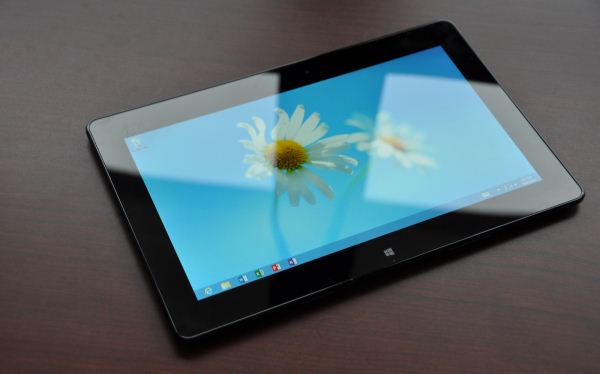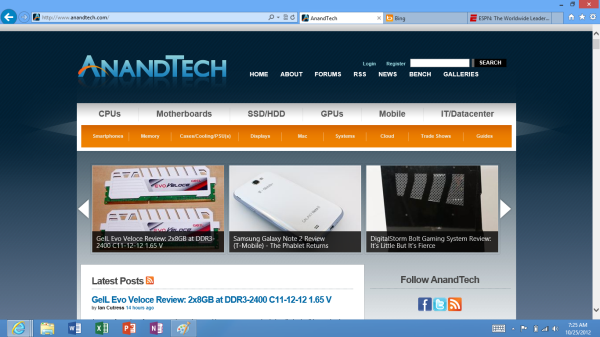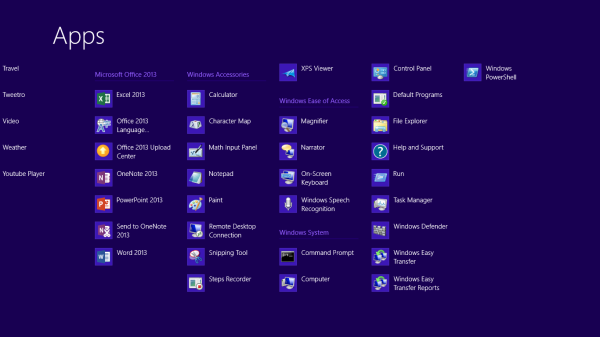The Windows RT Review
by Vivek Gowri & Anand Lal Shimpi on October 25, 2012 12:00 PM EST- Posted in
- Windows RT
- Operating Systems
- Microsoft
- Mobile
- Windows 8
- Tablets
Bridging the Gap, the Dichotomy of Windows RT
by Anand Shimpi
I described Windows RT as being a tablet OS with all of the underlying Windows-ness of Windows. You can get the big full screen app experience in tablet mode, but poke around your file system with Explorer or use Office 2013 like you would on a traditional notebook if you want to. If the two sides of Windows RT remained fairly separate that’d be one thing, unfortunately there are some dependencies between the two sides of the OS that keep the overall user experience from being as friendly as it is in iOS. There are still occasional reminders that you’re dealing with something that’s distinctly Windows here.
Most mobile OSes have done their best to hide the underlying file system and shell from the end user. Microsoft did, in my opinion, the smart thing and avoided hiding its roots with Windows RT. Although the new Start Screen is the default UI for Windows RT, there’s a big desktop tile front and center that will take you back to something far more familiar:
Unlike the Windows 8 desktop, you’re pretty limited in what you can do here. The only applications that are allowed to run in desktop mode under Windows RT are Explorer, IE10, Office 2013 and the command prompt (there are also all of the Windows specific tools and settings which I’ll get to shortly). Developers cannot make applications for Windows RT desktop mode and you can’t sideload anything here. Microsoft’s belief is that by completely locking down the system, requiring that applications only come from the Windows Store, it can avoid the pitfalls of viruses and malware that can plague Windows machines today.
Steve Sinofsky famously quoted an analyst when they asked if Windows RT would be backwards compatible with all of the legacy Windows viruses and spyware. The answer was an astounding no, and this is exactly why we can’t have open season on Windows RT desktop development. There’s also the obvious financial angle to all of this. Microsoft takes a cut of any apps sold through the Windows Store.
Coming from the perspective of a traditional Windows user, the lack of flexibility on the desktop seems wrong. From the perspective of the rest of the ARM based tablet space, it’s not a big deal. At least Windows RT gives you direct, first party access to the file system. There’s very little exposed through iOS, and with Android you need to download a third party app to get access to the file system.
Explorer works just as it would on a Windows 8 PC. The folder structure is exactly as you would expect it on any Windows machine. There are even some x86 remnants in the Windows RT install such as a C:\Windows\SysWOW64 directory complete with x86 binaries inside that obviously won’t run on your Windows RT tablet.
Internet Explorer in desktop mode works just like a traditional IE windows application would work. The desktop app actually controls settings and features for the Metro...err...fancy IE10. For example, if you want to change security settings, clear your history or empty your cache, you have to do all of these things from the IE10 desktop application. Fancy IE10 doesn’t expose them.
The command prompt is, well, a command prompt. It features all of the same commands that you could run before, although once again you can’t simply drop an x86 exe on your system and run it. Not having binary compatibility can be frustrating at times.
Although developers can’t build applications for Windows RT’s desktop, you can write and execute batch files. Keep in mind that if your batch file needs any additional support files (e.g. sleep.exe) you’ll need ARM versions of them which, unless they come from Microsoft, just isn’t happening.
As I mentioned earlier, there are a few other things you can run and do in RT’s desktop mode. Control Panel, event viewer, disk management and all of the other administrative tools that you’d expect to come with Windows are present in Windows RT (including regedit). There are also the little apps that Microsoft has always included, which also work in desktop mode (e.g. mspaint, calc, notepad, etc...)
Ultimately Windows RT is an ARM version of Windows with tablet makeup on. You still get all of the normal bits and pieces of Windows, minus some flexibility and of course, backwards compatibility.
For years we’ve been asking Microsoft to make a clean break with its legacy code and introduce a version of Windows that was built from scratch, with only support for the latest hardware. With Windows RT, Microsoft finally delivered some of that, but in a sort of weird, backwards way.
As Windows RT only supports the ARMv7 instruction set architecture, none of your old x86 applications will run on the platform. Microsoft hoped to avoid this being a problem by shipping an ARM version of Office 2013 Home & Student Edition with Windows RT tablets, and by directing users at the Windows Store for the rest of their application needs. Although it would’ve been possible for Microsoft to enable x86 compatibility through emulation or binary translation, performance would’ve likely been pretty bad.
The loss of backwards compatibility with years of Windows applications feels wrong, but from Microsoft's perspective you don't get that with iOS and Android so there's no real competitive disadvantage here. Why bother with an ARM based version of Windows to begin with? To bring competition to Intel and ensure that it will be able to deliver Windows to the new wave of ultra mobile devices (e.g. tablets). Intel hasn't been competitive on power or pricing at the low end (read: Atom) of the spectrum for years now. The introduction of Windows RT changed that. Atom Z2760 (Clovertrail) is around half the price of the cheapest Atom CPU of the past five years, and it's price competitive with solutions from Qualcomm. We have Windows RT to thank for that. Without pressure from ARM, Clovertrail would've started around $50 per chip just like Intel's low end parts had in the past. As AMD is no longer a pricing check for Intel in some of these new markets, Microsoft had to look for a new way to offer balance. Supporting ARM is its way of doing that. Until there's a new pricing/power/performance x86 competitor to Intel in tablets, ARM and Windows RT will remain.














233 Comments
View All Comments
Sivar - Thursday, October 25, 2012 - link
Vivek and Anand, did you experience the problems described by guidryp?cappasay - Thursday, October 25, 2012 - link
I may be wrong but from what I understand, all the crashes are about third-party apps forcefully closing down. Not native apps, and not a full system crash or anything like that. Presumably that will get better over time, as devs actually learn the platform (updates are getting pushed out daily). Slowdowns seem to have occurred in other videos, only you have a bunch of apps open at the same time.daboochmeister - Thursday, October 25, 2012 - link
Not according to other reviews. E.g. Matt Burns at TechCrunch, whose review reads as completely honest and informed, found crashes in the Metro^h^h^h^hodern apps, at least once per app, including MS's. And he found the new IE10 to be less than great.http://techcrunch.com/2012/10/23/microsoft-surface...
Other reviews have said much the same.
The more high-profile the site, the more likely they are to give it a positive review. Hmm ...
VivekGowri - Thursday, October 25, 2012 - link
For the record, I had exactly one random shutdown, and that was when I was switching between two different camera applications at the same time. It seemed forgivable, and other than that I legitimately had no major bugs/crashes when I was testing. My VivoTab RT was really solid from a software standpoint, I don't know what to tell you guys.daboochmeister - Thursday, October 25, 2012 - link
Hmm. Maybe the Surface RT then. Different hardware.PeteH - Thursday, October 25, 2012 - link
Just because some people run into bugs it doesn't mean everyone will.p05esto - Thursday, October 25, 2012 - link
Lame response. Have you personally found all of these bugs and problems you are posting about? Do you have a Windows tablet in your hands? Just curious. In other words you are a fool, lol.TEAMSWITCHER - Thursday, October 25, 2012 - link
I too, am finding myself a bit suspicious of these reviews. I just cant get excited about Windows 8...in any form. There is something about it that disgusts me. Let me try to explain......Windows 8 was not designed to solve problems for me. It was designed to solve problems for Microsoft - namely competing against Apple mobile devices and Google's web services. The only major new functionality is a UI that can driven by a touch screen - (Compete with Apple) and the new Start Screen which is huge billboard directing witless users to Microsoft Web services (Compete with Google.) What does Windows 8 do for me, the guy who runs Windows 7 on a single 27" monitor with a Mouse and Keyboard?
Many people have told me that the tiles will be great. Really? I think that Gadgets are better, as I don't need to leave my desktop for a simple status update! That Metro apps will be great - you can run two apps side-by-side. I can run many apps side-by-side in Windows 7. I have read that touch screen laptops will transform the Windows experience. Not for me, I don't want to look through a hundred finger smudges to see my work.
The UI is definitely NOT gorgeous! The overuse of inky pastel colors makes me cringe every time I look at it. The removal of glass Windows and drop shadows make the desktop look old, flat, and boring. Please don't give me the "Simple and Elegant" argument - its not that!
I fear that all my ranting is for naught. No matter what I say, type, or do it won't matter. Windows 8 will be a resounding success because there is simply nothing else the PC OEMs have to sell. Microsoft will no doubt take the stage at this fall's BUILD conference and proclaim that they were right.
Sadly for me I cannot agree. Windows 8 is where I and Microsoft part ways...forever! I'd like to think that the break up was amiable, but that's not what happened.
Microsoft tried to F@#K me!
steven75 - Friday, November 2, 2012 - link
It's also almost like Vivek is completely unaware of the iWork suite that came out with the iPad back in 2010. And it's completely touch-optimized, not just a ported hack from OS X.code65536 - Thursday, October 25, 2012 - link
So how exactly is this no-third-party-desktop-apps thing enforced? Are they simply relying on the fact that people haven't recompiled EXEs from Intel to ARM (no enforcement)? Are they restricting the availability of the compiler (but they need a native compiler for folks like driver developers)? Are they whitelisting EXEs? Or must EXEs have a certain digital signature before they are allowed to run?